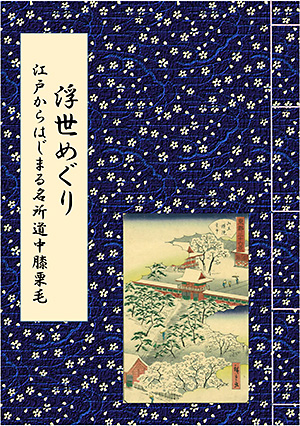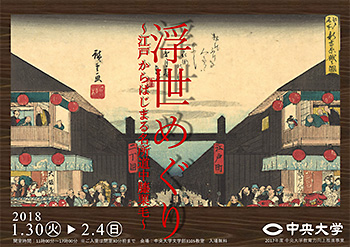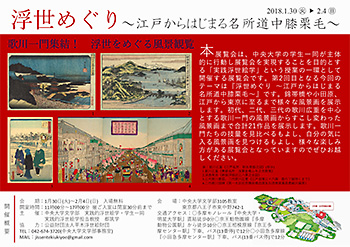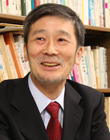Top>Research>Get the Feeling of Traveling from Ukiyo-e
 Index
Index
Get the Feeling of Traveling from Ukiyo-e
Manabu Tsuzuki
Professor, Faculty of Letters, Chuo University
Area of Specialization: Developmental Psychology
Enjoying travel
Travel programs are often shown on television. These programs feature leisure strolls through neighborhoods, travel through unfamiliar regions by transferring on different bus lines, trips to remote hot springs, and stays at luxurious Japanese inns. Some programs show beautiful scenery through the windows of trains and others feature interaction with local residents. Trips in both Japan and overseas are featured.
Travel enables us to escape from everyday life and enjoy special time. As such, the passage of time is different during everyday life and during trips. By watching television, people can have the feeling that they are traveling themselves. Emotions experienced during travel include surprise, thrills, happiness, and relaxation. Watching travel programs on television encourages us to actually take trips ourselves.
Travel guidebooks are essential companions when taking a trip. Bookstores are filled with travel guidebooks. There are both books and magazines, and different genres including travel journals. It is fun to simply thumb through the pages of these travel guidebooks. We enjoy finding appealing destinations, interesting architecture, delicious food, and special souvenirs.
Ukiyo-e is a travel guide

Poster
People also took trips in the Edo Period. One famous example is the pilgrimage to Ise. I’m sure that the pilgrimage was an enjoyable way for travelers to escape from their everyday life. Unlike today, it was then impossible to go traveling on a whim. The only means of transportation for common people was their own feet. They had to walk for days on end. They started walking before sunrise and arrived at their lodgings before sunset. This was repeated for countless days on long trips. This was the style of travel in the Edo Period. Such trips took a long time and cost a great amount of money. As such, most people were lucky to be able to embark on one such trip during their lifetime. It was truly an extraordinary experience.
Indeed, travel was a great luxury in the Edo Period. Common folk would use methods such as tanomoshi-ko (a mutual financing association) in order to save money for travel. It seems that people would embark on travel during their middle age by using money saved from hard work.
I am certain that common folk during the Edo Period experienced travel through the historic sites and scenic beauty depicted on ukiyo-e. Hiroshige Utagawa produced works such as the 53 Post Stations of the Tokaido and the 36 Sceneries of Mount Fuji. People undoubtedly felt great excitement and thrills upon viewing such ukiyo-e. I am sure that the art inspired them to go and see the scenery for themselves. In actuality, ukiyo-e featuring landscape paintings sold in huge amounts.
It can be said that ukiyo-e was akin to the travel guidebooks that we have today. People had to wait for many years before embarking on a trip. They had lots of time to plan their journey. It is certain that many people stared at ukiyo-e and dreamed of where their travels would take them.
How about taking a trip through ukiyo-e?

Pamphlet
In this article, I would like to introduce an exhibition of ukiyo-e. The concept of this exhibition is travel. The exhibition theme is “Traveling through Ukiyo: Shank’s Mare Round for Famous Sites Starting from Edo.”
Traveling through ukiyo has two meanings. The first is to experience travel through the paintings depicted on ukiyo-e. The second is to experience travel in a transient world from Edo to Meiji. Ukiyo-e displayed in the exhibition are listed below.
*
The first section depicts a trip through Edo. It begins with the high-spirited selling of bonito fish pictured in Nihonbashi Bridge from the 53 Post Stations of the Tokaido (Toyokuni III), continues with Cock Fair (Hiroshige II), Fireworks at Ryogoku (Hiroshige I), Teahouse at Ryogoku (Hiroshige I), Shin-Yoshiwara Niwaka (Hiroshige I), Year-End Festival at Asakusa (Hiroshige I), Oji Kitsunebi (Hirokage), Shinmeigu Shrine (Hirokage), and ends with Snowy Sanno Gongen (Hiroshige II).
The second section is a trip through famous sites. It includes Dewa Chokaisan(Hiroshige II), Kegon Falls at Mount Nikko (Adachi Ginko), Odawara (Hiroshige II), Onjuku (Hirokage, Kuniyoshi), The Eight Views of Omi (Keisai Eisen), Suzuka-no-Seki (Kawanabe Kyosai), Iwakuni Kintai Bridge (Utagawa Sadahide), and Small Village Between Shono and Kameyama (Toyokuni III).
The third section is a trip through Tokyo. It features scenery from the Meiji Period including Steam Railway on the Takanawa Coast (Hiroshige III), Large Fireworks at Ryogoku (Kunimaro), River Festival at Ryogoku (Kunimasa IV), Railway Under Shinagawa Yatsuyama Bridge (Hiroshige III), and From Kyobashi to Shinbashi (Kuniteru Utagawa II).
*
The exhibition “Traveling through Ukiyo: Shank’s Mare Round for Famous Sites Starting from Edo” features two types of travel. The first is a spatial journey from Edo to different regions. The second is a temporal journey that spans the Edo Period and Meiji Period as the city of Edo transforms into the city of Tokyo. This exhibition creates a wondrous experience in which travelers take a journey from Edo to various regions, only to find that Edo has transformed into Tokyo during their travels. I encourage you to enjoy this unique ukiyo-e experience.
Theme: Traveling through Ukiyo: Shank’s Mare Round for Famous Sites Starting from Edo
Period: January 30 (Tues.) to February 4 (Sun.), 2018 Hours: 11:00 to 17:00
Venue: Room #3105 in the Faculty of Letters Building, Tama Campus, Chuo University
Free admission
Preparing the journey through ukiyo-e

Flyer (front)

Flyer (back)
The current exhibition was made possible by a Chuo University project on Promoting Educational Power entitled “Active Learning through an Ukiyo-e Exhibition.” Continuing from last year, this is the second time that an exhibition has been held. The primary object of the project is that students will be involved with planning and running an ukiyo-e exhibition. A leading role was played by 12 students from the practical ukiyo-e course, an extracurricular program in the Faculty of Letters. The students range from undergraduate freshmen to graduate students in the first year of the master’s program. They also come from a wide variety of faculties and academic majors . As an extracurricular program, students do not receive any credits for taking the practical ukiyo-e course. This shows the enthusiasm of students involved.
I will now explain activities conducted by students until the completion of the exhibition. During their summer break, students visited ukiyo-e exhibitions, submitted a written report to prepare themselves for the start of the program. Upon entering the second semester, classes were held once per week. We brought in Ms. Etsuno Moriyama and Ms. Masako Matsumura, curators at the Hiraki Ukiyo-e Museum (Hiraki Ukiyo-e Foundation), to serve as instructors. These two women are highly professional in their field; the students, on the other hand, were essentially blank slates, except for their interest and curiosity about ukiyo-e prints. They had no real knowledge of ukiyo-e nor any experience in art exhibitions. The instructors took the time to carefully explain everything to them, and we are deeply grateful for their contributions. We received the prints to be used in the exhibition on loan from the Hiraki Ukiyo-e Foundation, thanks to extensive support and understanding from Mr. Mitsunobu Sato, Director of the Hiraki Ukiyo-e Museum. There are no words to express our gratitude.
The practical ukiyo-e course consisted of two main parts. The first was acquiring a basic knowledge of ukiyo-e. In addition to learning about the history of ukiyo-e and artist lineages, students learned how to read the information imprinted on the paintings, such as artist signatures and seals, publisher seals, and official seals of approval.
The second part of the course was the work involved in preparing for the exhibition. To start, each student was in charge of preparing reports on one to three ukiyo-e pieces. The reports started by listing the dimensions (height and width measurements) of the work. They then specified the title, artist, publisher, and publication year. Next, students researched the figures and the landscapes on the piece. The information was then used to prepare the captions that would accompany each print in the exhibition.
Students also prepared flyers, posters, and brochures to advertise the event. This year, students split into two groups. One group was in charge of brochures, while the other handled flyers and posters. Students used computers to create the materials, and the guidance of the two curators was also invaluable during this process. The posters displayed throughout the university were extremely eye-catching and appealing.
The brochure showed an image of each print with its attached explanatory notes, an editorial article, and a map of Japan. Ms. Moriyama and Ms. Matsumura both reviewed the students’ compositions, offering precise guidance from their expert perspectives.
Now came time to actually put on the exhibition. The explanatory notes were printed and affixed to panels, while mats were cut out to the right size so that the prints could be properly framed and hung. The students laid a plan for how the panels should be arranged and the order in which the prints should be hung. They then hung the framed ukiyo-e prints and explanations on each panel prepared at the exhibition venue. Finally, everything became ready for the day of the exhibition to arrive. The students even divided up reception responsibilities, taking turns working in pairs.
- Manabu Tsuzuki
Professor, Faculty of Letters, Chuo University
Area of Specialization: Developmental Psychology
- Manabu Tsuzuki was born in Tokyo in 1951. He graduated from the Faculty of Education, Tokyo University of Education, and completed the Master’s Program in its Graduate School of Education. He completed the Doctoral Program in the Graduate School of Psychology, University of Tsukuba. He has obtained a PhD in education.
He served as a Full-time Lecturer, Assistant Professor at Ogaki Women’s College and an Assistant Professor in the Faculty of Letters, Chuo University before assuming his current position in 1994.
He was the Dean of the Chuo University Graduate School of Letters from November 2009 to October 2013, and was the Dean of the Chuo University Faculty of Letters from November 2013 to October 2017.
Research topics
Manabu Tsuzuki has been studying time perspectives since around 1980. Between 1997 and 2011, he used a longitudinal study to explore the process by which time perspectives change along with environmental transitions, publishing his findings. His publications include: University Students’ Career Choice and Time Perspective [Daigakusei no Shinro Sentaku to Jikanteki-Tembo] (Nakanishiya Shuppan, 2007); School Transition from Elementary to Junior High School and Time Perspective [Shogakko kara Chugakko e no Gakko Iko to Jikanteki-Tembo] (Nakanishiya Shuppan, 2008); School Transition from Junior High to High School and Time Perspective [Chugakko kara Koko e no Gakko Iko to Jikanteki-Tenmo] (Nakanishiya Shuppan, 2009); and High School Students’ Career Choice and Time Perspective [Kokosei no Shinro Sentaku to Jikanteki-Tembo] (Nakanishiya Shuppan, 2014). Last year, he published his tenth single-authored work, How to Write a Good Report: A Handbook for First-year University Students [Daigaku Ichinensei no tame no Tsutawaru Repoto no Kakikata] (Yuhikaku Publishing, 2016).
- Research Activities as a Member of Research Fellowship for Young Scientists (DC1), Japan Society for the Promotion of Science (JSPS) Shuma Tsurumi
- Important Factors for Innovation in Payment Services Nobuhiko Sugiura
- Beyond the Concepts of Fellow Citizens and Foreigners— To Achieve SDGs Goal 10 “Reduce Inequality Within and Among Countries” Rika Lee
- Diary of Struggles in Cambodia Fumie Fukuoka
- How Can We Measure Learning Ability?
—Analysis of a Competency Self-Assessment Questionnaire— Yu Saito / Yoko Neha - The Making of the Movie Kirakira Megane









